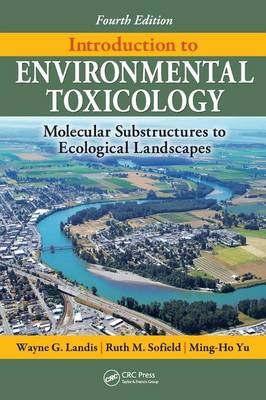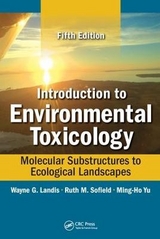
Introduction to Environmental Toxicology
Crc Press Inc (Verlag)
978-1-4398-0410-0 (ISBN)
- Titel erscheint in neuer Auflage
- Artikel merken
After fifteen years and three editions, Introduction to Environmental Toxicology: Molecular Substructures to Ecological Landscapes has become a standard that defines the field of environmental toxicology, and the fourth edition is no exception. The authors take an integrated approach to environmental toxicology that emphasizes scale and context as important factors in understanding effects and management options.
New in the Fourth Edition:
New author, Dr. Ruth M. Sofield
8-page color insert
New chapter on fate and transport of contaminants
Emphasis on the use of all types of models in understanding how nature works
Revised sections on synergy and atrazine toxicity
Updated coverage of the analysis of impacts to populations, communities and ecosystems
Enlarged risk assessment chapter with an in-depth description of a regional scale risk assessment
This edition benefits from the insight of a new author, Dr. Ruth M. Sofield, who prepared the new chapter on the fate and transport of contaminants. The relationship between structure and toxicological properties has been a major theme of this book since its inception and this new chapter expands this fundamental concept to include fate and transport. In the early chapters the use of models in science is discussed and this theme carries throughout the rest of the book.
So much has changed in the fifteen years since the publication of the first edition. The mid-1990s seem so long ago, when our understanding of environmental toxicology was very basic. Ecological risk assessment was in its very early stages and the consideration of the effects of toxicants on landscapes was only beginning. Computation was still hard, genes stayed put, and it was only becoming recognized that xenobiotics could have hormonal effects — developments that are taken for granted in this edition. Written by authors who teach this subject, a feature that is reflected in their straightforward style, the book provides a foundation for understanding environmental toxicology and its application.
Western Washington University, Bellingham, USA Western Washington University, Bellingham, USA
Introduction to Environmental Toxicology
Environmental Toxicology as an Interdisciplinary Science
A Brief History and Organizations in Environmental Toxicology
Interactions and Connections of Environmental Toxicology to the Management of Ecological Systems
Legislation
Introduction to This Textbook
Study Questions
Frameworks and Paradigms for Environmental Toxicology
The Fundamentals
Models
Fundamental Models for Environmental Toxicology
The Classical Viewpoint for Classifying Toxicological Effects
Chemical Physical–Chemical Characteristics
Bioaccumulation/Biotransformation/Biodegradation
Receptors and the Mode of Action
Biochemical and Molecular Effects
Physiological and Behavioral Effects
Population Parameters
Community Effects
Ecosystem Effects
An Alternative Framework Incorporating Complexity Theory
Spatial and Temporal Scales
Combining Scale and Ecological Dynamics: The Hierarchical Patch Dynamic Paradigm
Strategy and Tactics in the Use of Models in Environmental Toxicology
Study Questions
References and Suggested Readings
An Introduction to Toxicity Testing
Introduction
The Dose-Responsive Curve
Thresholds and Hormesis
Terminology Based upon Hypothesis Testing
Classification of Toxicity Tests
Design Parameters for Single-Species Toxicity Tests
Limitations and Alternatives to Hypothesis Testing
Commonly Used Methods for the Calculation of Endpoints
Comparison of Calculations of Several Programs for Calculating Probit Analysis
Hypothesis Testing
Curve Fitting and Regression Modeling versus Hypothesis Testing
The Design of Multispecies Toxicity Tests
Univariate Methods
Multivariate Methods
Visualization
Summary of Design Guidelines for Multispecies Toxicity Tests
Standard Methods
Study Questions
References and Suggested Readings
Survey and Review of Typical Toxicity Test Methods
Introduction
Animal Care and Use Considerations
Single-Species Toxicity Tests
Multispecies Toxicity Tests
Summary
Study Questions
Appendix 4.1: The Natural History and Utilization of Selected Test Species
The Fate and Transport of Contaminants
Introduction
Transport Mechanisms
Persistence
Biotransport
Abiotic Degradation/Transformation
Multimedia Box Models
Equilibrium
The Fugacity Approach
Bioconcentration versus Biomagnification
Bioavailability
Summary
Study Questions
References and Suggested Readings
Uptake and Modes of Action
The Damage Process
Atmospheric Pollutants and Plants
Mechanisms of Action
Specific Modes of Action in Detail
Receptor-Mediated Toxicity, Endocrine Disruption
Introduction to QSAR
Study Questions
References and Suggested Readings
Factors Modifying the Activity of Toxicants
Introduction
Physicochemical Properties of Pollutants
Time and Mode of Exposure
Environmental Factors
Interaction of Pollutants
Toxicity of Mixtures
Biological Factors Affecting ToxicityStudy Questions
References and Suggested Readings
Inorganic Gaseous PollutantsSulfur Oxides
Nitrogen Oxides
Ozone
Carbon Monoxide
Study Questions
References and Suggested Readings
Fluoride as a Contaminant of Developing Economies
Environmental Sources and Forms of Fluoride
Industrial Sources of Fluoride Pollution
Effect on Plants
Effect on Animals
Effect on Human Health
Biochemical Effect
Study Questions
References and Suggested Readings
Heavy Metals
Introduction
Lead
Cadmium
Mercury
Study Questions
References and Suggested Readings
Biotransformation, Detoxification, and Biodegradation
Introduction
Metabolism of Environmental Chemicals: Biotransformation
Types of Biotransformation
Mechanisms of Biotransformation
Consequences of Biotransformation
Microbial Degradation
Bioremediation
An Example of a Detoxification Enzyme: The Organophosphate Acid (OPA) Anhydrolases
Study Questions
References and Suggested Readings
Ecological Effects from Biomarkers to Populations
Introduction
Terminology and Context
The Key to Context: The Hierarchical Patch Dynamics Paradigm
Measurement of Ecological Effects at Various Scales or Levels of Biological Organization
Bioaccumulation/Biotransformation/Biodegradation
Molecular and Physiological Indicators of Chemical Stress Biomarkers
Assemblage and Community Parameters
Effects at the Population Scale
Interacting Populations in a Patchy Environment
The Importance of Patch Dynamics
Implications
Appendix: Age-Structured Population Modeling in Detail
Study Questions
References and Suggested Readings
Ecological Effects: Community to Landscape Scales of Toxicological Impacts
Introduction
Community Effects
Effects on Ecosystems or Ecological Structures
Application of Multivariate Techniques
Pollution-Induced Community Tolerance
Interpretation of Ecosystem Level Impacts
An Alternative Model: The Community Conditioning Hypothesis
The Design of Field Studies
Making Decisions
Appendix: Multivariate Techniques—Nonmetric Clustering
Study Questions
References and Suggested Readings
Ecological Risk Assessment
Introduction
Basics of Risk Assessment
Ecological Risk Assessment
Ecological Risk Assessment Framework
Risk Characterization
Techniques in Ecological Risk AssessmentStudy Questions
References and Suggested Readings
Appendix A: References for Toxicity Testing and Interpretation, Compiled by April J. Markiewicz
Index
| Erscheint lt. Verlag | 7.1.2011 |
|---|---|
| Zusatzinfo | 8-page color insert; 60 Equations; 70 Tables, black and white; 207 Illustrations, black and white |
| Verlagsort | Bosa Roca |
| Sprache | englisch |
| Maße | 178 x 254 mm |
| Gewicht | 1179 g |
| Themenwelt | Naturwissenschaften ► Biologie ► Biochemie |
| Naturwissenschaften ► Biologie ► Ökologie / Naturschutz | |
| Naturwissenschaften ► Chemie | |
| Technik ► Umwelttechnik / Biotechnologie | |
| ISBN-10 | 1-4398-0410-9 / 1439804109 |
| ISBN-13 | 978-1-4398-0410-0 / 9781439804100 |
| Zustand | Neuware |
| Informationen gemäß Produktsicherheitsverordnung (GPSR) | |
| Haben Sie eine Frage zum Produkt? |
aus dem Bereich



